コラム
落合憲弘
John Sypal
タカザワケンジ
なぎら健壱

This month’s installment of this Tokyo Photobook Tour takes us westward out of the concrete metropolis via Shinya Arimoto’s brilliantly titled “Tokyo Debugger”. Published by Zen Foto Gallery in 2021, this book is a collection of photographs taken during the photographer’s visits to Tokyo prefecture’s westernmost edge: the densely wooded Okutama mountains.
For eleven years, each August and September, a few times a week Arimoto would load up his bag with a RolleiflexTLR and a Mamiya RZ with a macro lens (later switching to a Bronica SQAI with a 1:1 macro lens), a ring-flash unit, and plenty of Kodak Tmax400 film.
One ninety-minute train ride later he’d buy two onigiri rice balls at the local 7-11 and set out into the woods to photograph until night fell- or for his trips which began at dusk, until the sun rose. On those humid mornings he would return to the city to sleep through the day- only to repeat his nocturnal prowling a few evenings later.
While at first glance a book of bugs, Tokyo Debugger is actually a collection of portraiture. Well regarded for his outstanding photographs of people he encountered on the plains of Tibet and streets of Shinjuku, Arimoto applied his free, open approach to the far smaller denizens of Okutama- nameless characters that, when seen through a macro lens and wildly illuminated by his flash, assume a greater, more bizarre presence than one would think possible. These citizens, seen here in all their scaled, segmented glory share our world but seem from another dimension. Granted, such subject matter isn't for everyone- anyone with a fear of bugs will want to stay away. Then again, this may be the perfect gift for the entomologist in your life. I’m curious how a scientist might approach this work- The reflection of Arimoto’s ring flash in these creatures’ eyes gives each a mysterious, unifying character- a spirit that’s closer to animism than biology.
Alone, these macro bug-portraits would be interesting enough but on his visits to these hills Arimoto also photographs the landscape itself- one often altered by humans through mining and industry- and general existence.
The thread of this book- the web, if you will- is the slightly unsettling sensation of how lines between man and nature, or even man and insect, are blurred. A reader’s careful contemplation will reveal that nearly each image includes a human-made creation in it- a rotting, collapsed house in the woods, the chrome housing of a bicycle headlight, or even a machine-milled metal surface with patterns which visually echo those of a moth wing. A sense of scale is altered throughout the pages- here one finds enlarged reverberations of the insects’ micro-worlds in images of rusted construction equipment, clawed, scarred hills, and decrepit concrete structures in overgrown weeds. A Western viewer might try to interpret an ecological message- but looking closely, there is none.
There is no “Good” or “Evil” in Arimoto’s work- not towards individuals or mankind as a whole. Whether of rough-sleepers in Shinjuku or strip-mined hills, his work is unconcerned with set morals or predictable messages. Life is appreciated. We’re all here, doing what we can, given the circumstances. He’s noted that since humans are part of nature, what humans create ought to be considered part of it. He demonstrates a “fairness” (realness?) towards the world- one that focuses on what’s there rather than how it ought to be. His selection of “what’s out there”, results in an impressively individual view of reality- lots of small things work to suggest a bigger picture.

As an object, Tokyo Debugger is an exquisite book. By wrapping the book in contrast of bold purple and iridescent green foil designer Koichi Ino & Arimoto referenced both arthropodan coloring and the anime Neon Genesis Evangelion . This shimmering a beetle-shell green wraps around the book’s fore-edge and peeks through purple cover to spell out the title in an ingenious application of tiny holes that mimics compound eyes. Inside, the dark pages have a slight sheen to them- the images are presented on black pages- a design choice that sets the pictures apart from both any other object near the reader and their expectations as to what a book of photographs might look like. (Had the pages simply been white this book would have been more about entomology than photography.)
Debugger is a fascinating work- it's the result of obsessive curiosity and dedicated labor; of long nights, close-up.
I’ll leave you with an excerpt of his statement accompanying his show at Zen Foto in 2021:
“Many people have questioned me why I would create a group of work focused on bugs, since I have mainly focused on my work on portraits of human beings for more than 20 years. However, I have previously written in the statement of previous work “Tokyo Circulation” that “the dense sprawl of Tokyo is an ecosystem with magnificent circulation”.
That concept originated from the idea that If honeycombs, a meticulously calculated structure created by bees as a living creature are a part of nature, then cities created by the living creature called human beings should also be a part of nature. I once said that my previous work and this work “belong to the different sides of the same coin”, but for example, just as a piece of blank paper has neither a front or a back, the human world and the bug world are also inseparable. I call them “mushi senpai” (“bug senior”) with all my respect as those little ones have been living on this planet since the dawn of time.
——Shinya Arimoto
- Also, I named this work “Tokyo Debugger” for two reasons, one with the simple meaning of “searching for bugs in Tokyo” and the other as a metaphor, questioning whether “debugging (removing)” in the history of the earth would happen to the bugs or to the human beings.
Perhaps the human world is insignificant compared to the history of the bug seniors, and to them we may be an ephemeral existence that suddenly appears and quietly disappears in their world.”
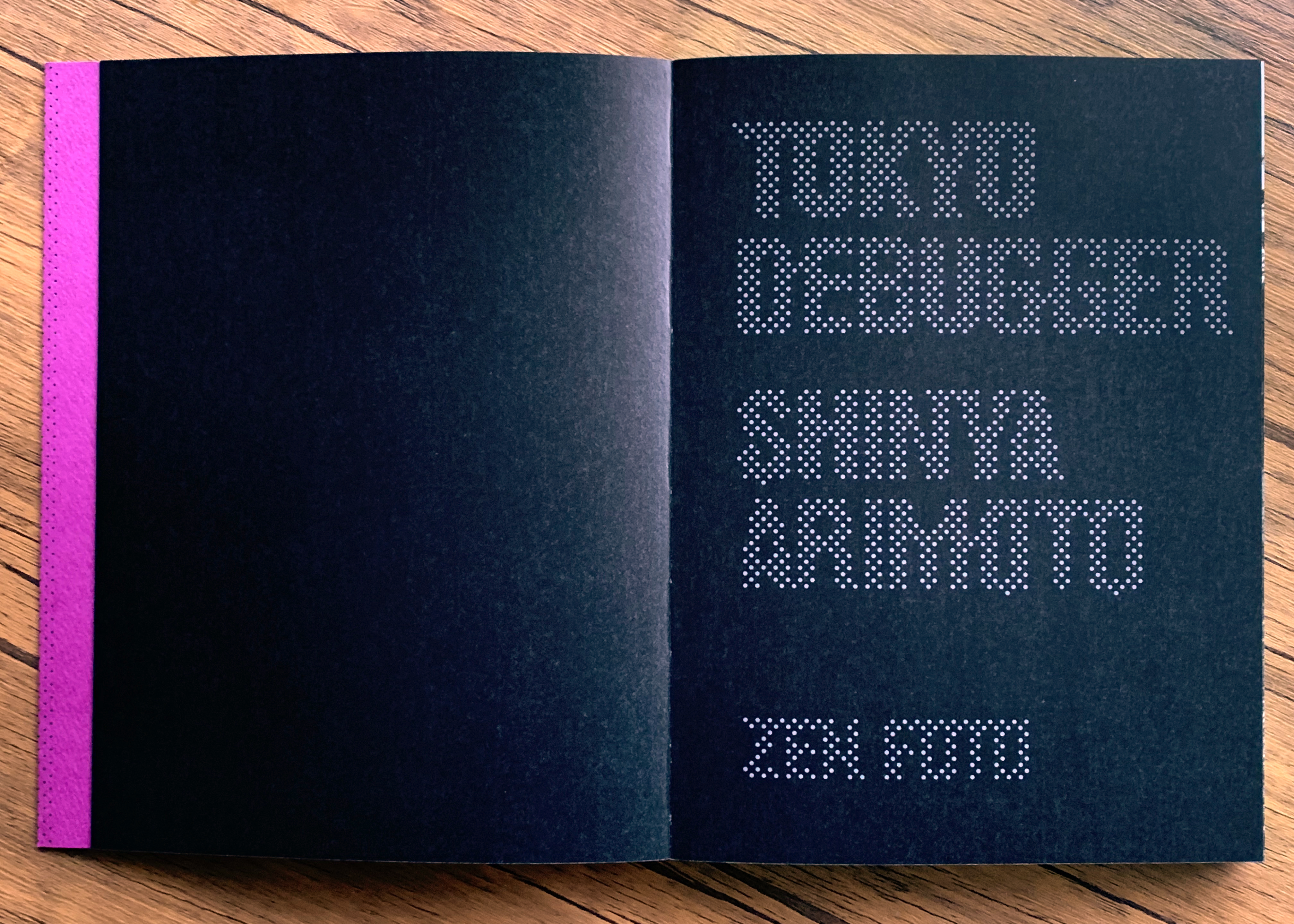
今月の「東京フォトブックツアー」では、有元伸也さんの写真集『Tokyo Debugger』(Zen Foto、 2021年)、コンクリートジャングルから離れた東京都の最西端、木々が密集している奥多摩の山々を訪れます。
有元さんは11年間、毎年8月から9月にかけて、毎週数回、ローライフレックスTLRとマクロレンズ付きマミヤRZ(その後はブロニカSQAIと1:1マクロレンズを付け替え)、リングフラッシュ、そして何本ものコダックT-MAX400フィルムを鞄に詰め込んで森へ向かいました。
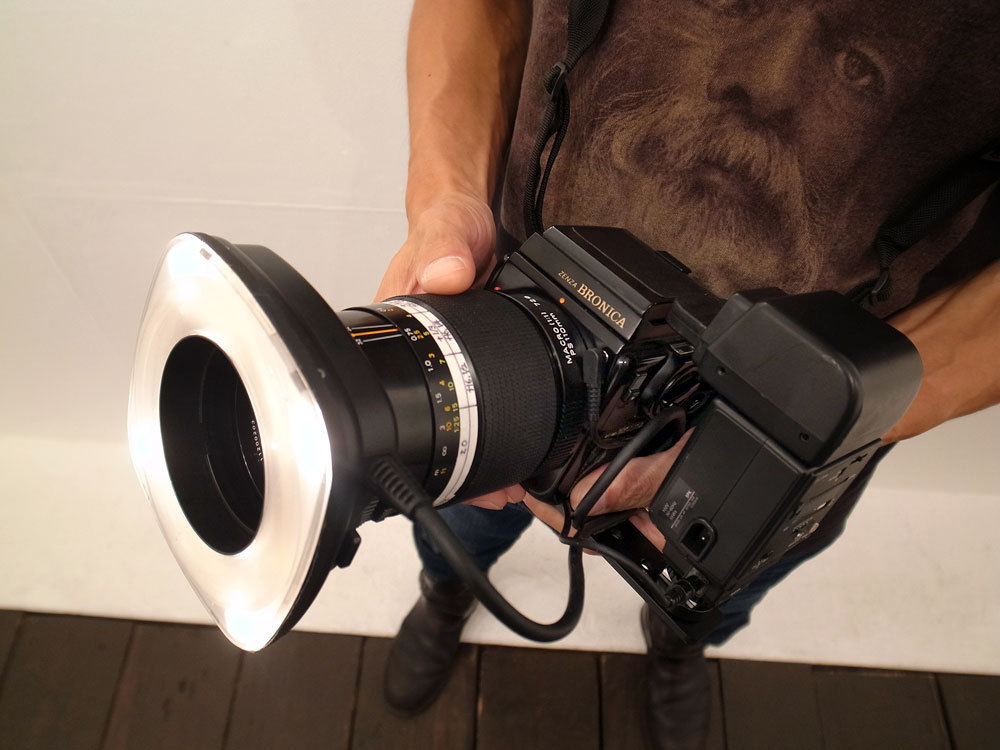
電車で片道90分。奥多摩に到着するとセブンイレブンでおにぎりを2つ買って森に入り、昼すぎからスタートする撮影は、夜をこえて太陽が昇るまで続きます。有元さんはオールナイト撮影が終わると、自宅に戻って日中眠り、数日後の夜にまた徘徊するのです。
『Tokyo Debugger』は一見すると"虫の本"という印象をもつかもしれませんが、実はポートレート集なのです。
チベットの平原や、新宿の街角で出会った人々を撮影した写真で知られる有元さん。
その自由な発想で奥多摩の小さな住人たちに向けて、マクロレンズを通し、フラッシュで荒々しく照らし出された名もなきキャラクターたちは、想像以上に大きく、奇妙な存在感を放っています。この写真に写っている森の民たちは、鱗状で断片的な輝きを放ちながら、同じ世界にいるのにも関わらずまるで異次元から来たかのように見えます。有元さんの放つリングフラッシュが生き物の目に映り込むことで、生物学というよりアニミズムに近い精神が生まれ、神秘的で統一感のある作品に仕上がっています。
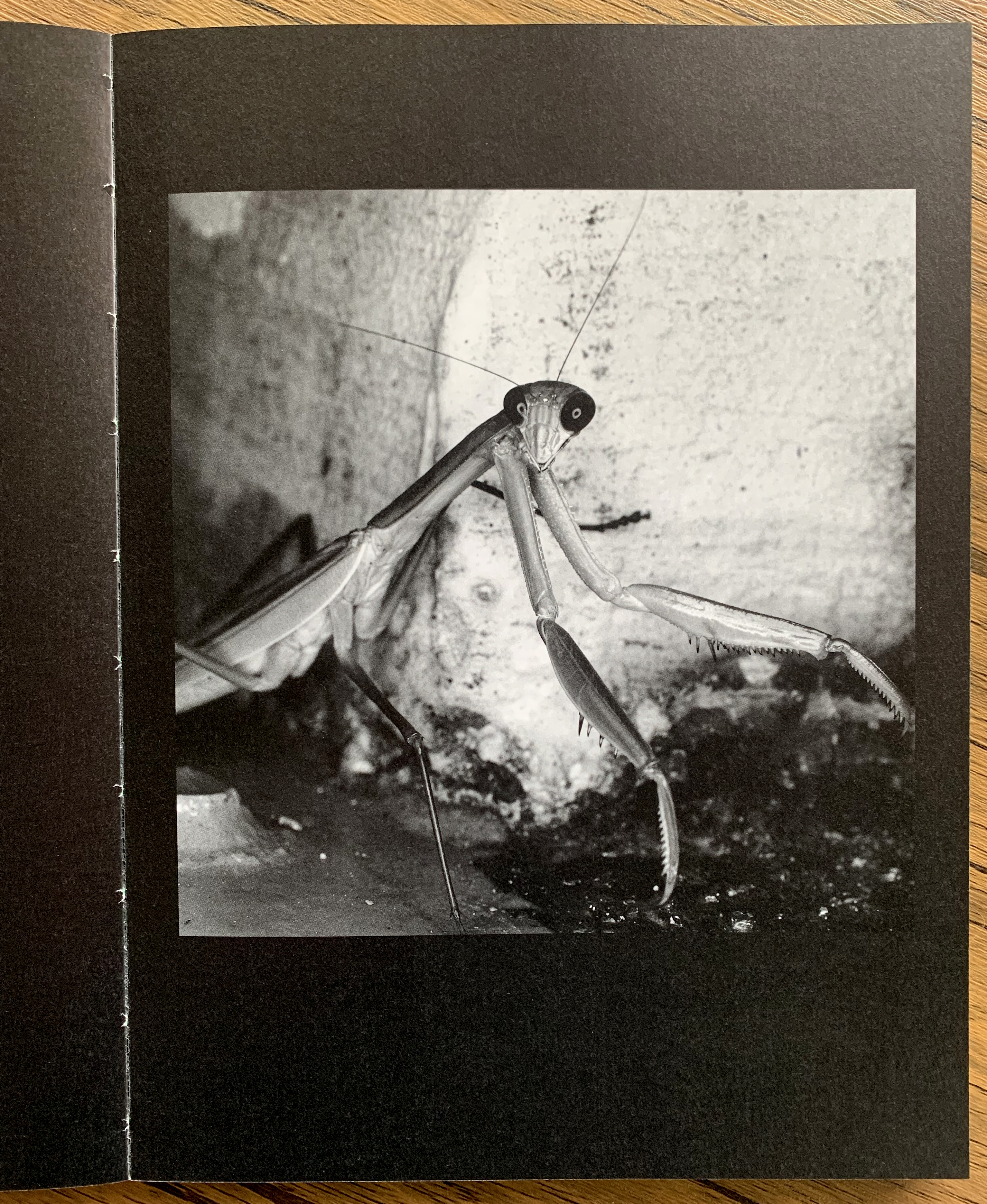
限局性恐怖症※ の方はこの本を手に取れないかもしれませんが、昆虫学者の知り合いへのプレゼントには最適でしょう。
※特定の状況、環境、対象に対して、非現実的で激しい不安や恐怖感が持続する状態
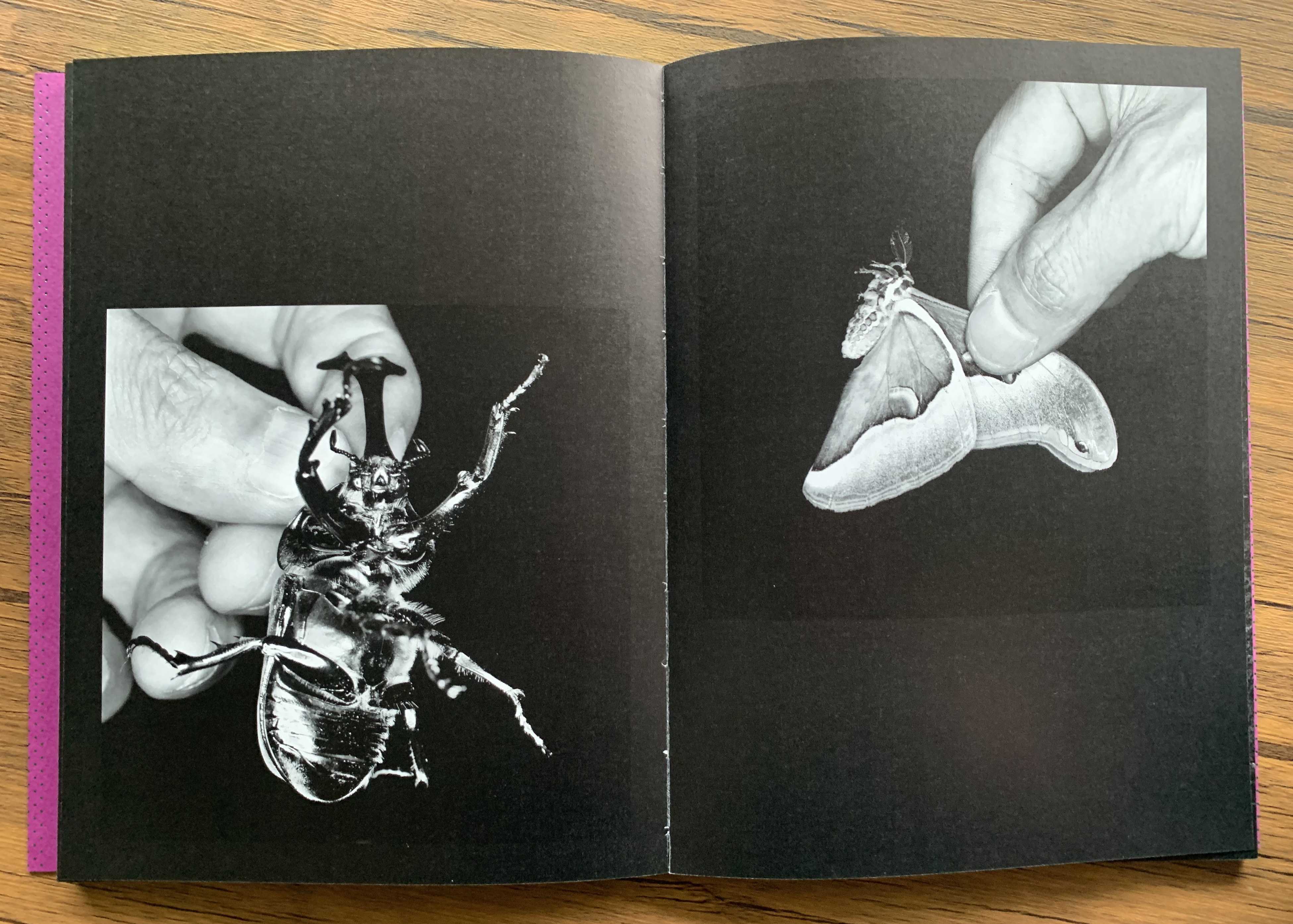
マクロレンズで写つし出された虫のポートレートを見るだけでも十分面白いのですが、有元さんはこの丘を訪れて、鉱山や産業など、人間によってしばしば改変される風景そのものや、一般的な存在も撮影しています。

この写真集では、人間と虫の混在する世界が、糸のようにより集まって構成されています。人間と自然、あるいは人間と昆虫の間の境界線がいかに曖昧であるかという、少し不穏な感じを覚えます。
森の中で朽ちて倒壊した家、自転車のヘッドライトのクローム・ハウジング、蛾の羽模様のように機械加工された金属の表面など、読者は深く観察することで、ほぼすべての画像に人間が作り出したものが含まれていることに気づくでしょう。錆びた建設機械、爪痕のついた丘、雑草が生い茂った中にある老朽化したコンクリート構造物など、昆虫のミクロの世界が拡大されているのです。 欧米の人はエコロジー的なメッセージを読み取ろうとするかもしれませんが、しかしよく見るとそこにメッセージは何もありません。
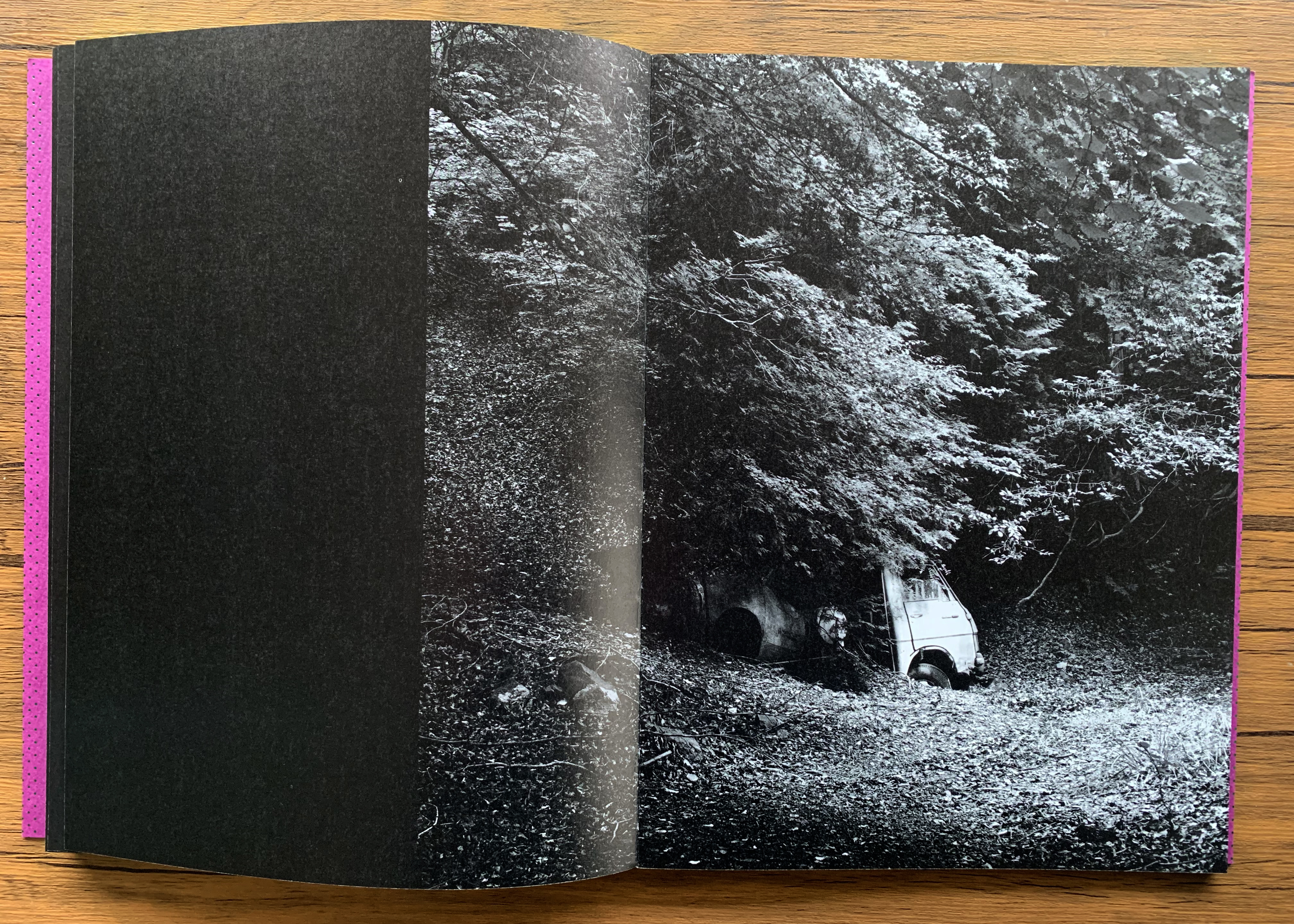
どこで撮っていても、有元さんの写真には「善」も「悪」もありません。
社会や種の起源(スピーシズ)に対しても、個人に対しても。新宿の路上生活者であれ、採掘された丘であれ、彼の作品は決まったモラルや予測可能なメッセージには無頓着です。私たちは皆ここにいて、与えられた環境の中でできることをやっているのです。
また「人間は自然の一部であり、人間が作り出したものは自然の一部であると考えるべきだ」と有元さんは述べています。あるべき姿というよりも、そこにあるものに目を向ける。世界という「公平」で「リアリティー」あるものを選ぶことで、個性的な現実世界が生まれ、それらを積み重ね並べることによって、大きな「写真」になるのです。
天才的な題名でもある『Tokyo Debugger』は「本」としてもユニークな作りです。
デザイナーの伊野耕一さんは、大胆な紫と虹色の箔のコントラストで本を包むことで、節足動物の色彩とアニメ「新世紀エヴァンゲリオン」を参照しました。甲虫の殻のようなグリーンは、表紙の紫を突き破って前縁に達し、複眼を模した小さな穴が巧妙に施されています。ページは半光沢紙を用いており、真っ黒のページに画像を配置することで、現実世界や一般的な写真集のイメージとは一線を画すデザインになっています。もしページが白かったら、この本は写真というより昆虫学の本になっていたかもしれません。

『Tokyo Debugger』が魅力的な作品なのは、執拗なまでの好奇心と、献身的な労働の結果であり、長い夜とクローズアップの産物です。
有元さんの展覧会に添えられたステートメントを抜粋して締めくくりたいと思います。
有元伸也
- 二十余年にわたりポートレート作品を主に制作してきた私が虫の姿を中心とした作品を作ることに対し疑問を呈される方も多い。しかし前作『Tokyo Circulation』のステートメントにも「私の目に映る東京は、壮大な循環を持つ一つの生態系だ」との一文を記している。これは蜂という生物が作った緻密で計算された構造物〈蜂の巣〉を自然の一部とするならば、人間という生物が作り上げた都市もまた自然の一部と言えるのではないかという着想から得たものだった。 その前作と今作を「コインの裏表のような関係」と表現したことがあったが、例えば真っ白な一枚の紙には裏も表もないように、人間世界と虫世界も而二不二の間柄であり、この惑星に太古より暮らす小さな彼等のことを僕は敬意を込めて「虫先輩」と呼んでいる。また『Tokyo Debugger』というタイトルには「東京で虫(bug)を探す」という単純な意味と、地球の歴史において「デバッグ(取り除く)」される存在は果たして虫と人類どちらなのか?という隠喩を込めた。 ともすれば、人間世界なんてものは虫先輩の歴史に比べたら微々たるもので、彼らの世界に突然ひょっこり現れて、やがてひっそり消えてゆくだけの儚い存在なのかもしれない。
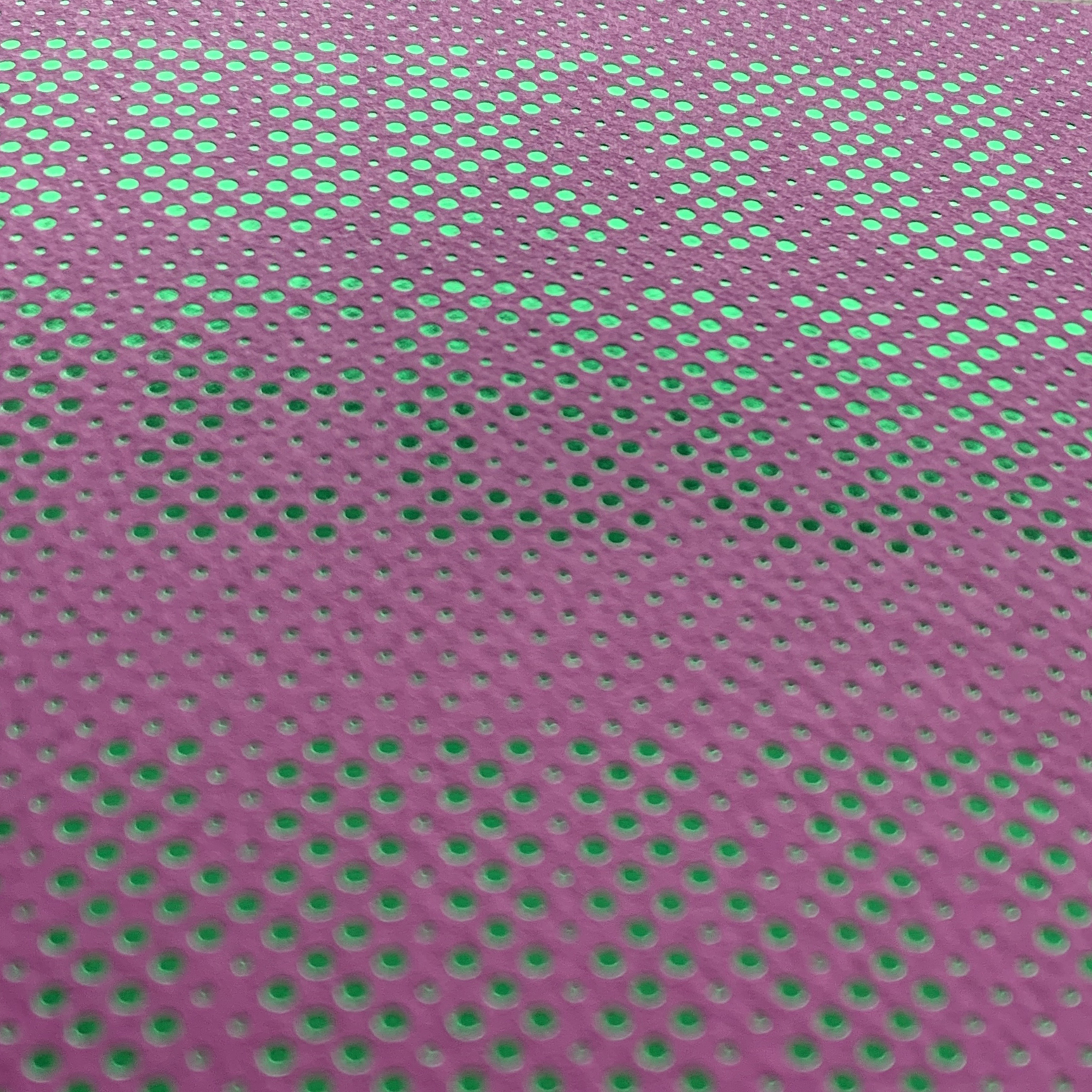
有元伸也『Tokyo Debugger』
禅フォトギャラリー(Zen Foto)2020年発行
判型:257×190mm、160ページ、掲載作品78点、エディション1000
6,050円(税込)
 26 Duets? Duels? Near-overlaps of time and Space across Tokyo. 東京の時間と空間が重なり合う写真集ツアー
2025/04/04
26 Duets? Duels? Near-overlaps of time and Space across Tokyo. 東京の時間と空間が重なり合う写真集ツアー
2025/04/04
 25 Naoki Ishikawa "TOKYO The City Where I Was Born" 石川直樹『東京 ぼくの生まれた街』
2024/01/05
25 Naoki Ishikawa "TOKYO The City Where I Was Born" 石川直樹『東京 ぼくの生まれた街』
2024/01/05
 24 山内道雄 Michio Yamauchi『TOKYO UP CLOSE』
2023/10/20
24 山内道雄 Michio Yamauchi『TOKYO UP CLOSE』
2023/10/20
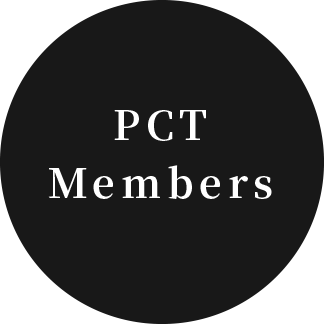

PCT Membersは、Photo & Culture, Tokyoのウェブ会員制度です。
ご登録いただくと、最新の記事更新情報・ニュースをメールマガジンでお届け、また会員限定の読者プレゼントなども実施します。
今後はさらにサービスの拡充をはかり、より魅力的でお得な内容をご提供していく予定です。
 「Photo & Culture, Tokyo」最新の更新情報や、ニュースなどをお届けメールマガジンのお届け
「Photo & Culture, Tokyo」最新の更新情報や、ニュースなどをお届けメールマガジンのお届け 書籍、写真グッズなど会員限定の読者プレゼントを実施会員限定プレゼント
書籍、写真グッズなど会員限定の読者プレゼントを実施会員限定プレゼント